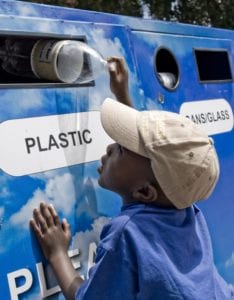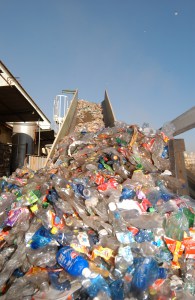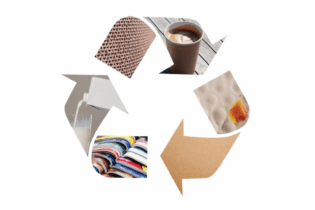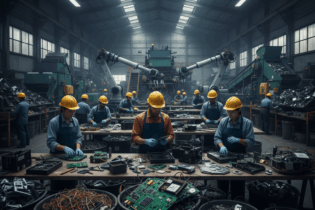Key findings for the 2015 plastics recycling figures
- South Africa mechanically recycled 292 917 tons of plastics in 2015 – an increase of 3 % year on year from 2014.
- Over the last five years the compounded growth in plastics recycling was 5 % per annum.
- Domestic production of virgin polymers totalled 1 490 000 tons in 2015, growing 6.4 % from 2014. This growth would essentially be as a result of the weakening exchange rate against international currencies that lead to local procurement of plastics products rather than imports.
- A total of 310 641 tons of plastics were diverted from landfill in 2015. This is 1.6 % less than in 2014 and is due to the significant reduction in the export of recyclable waste.
- The overall diversion from landfill rate was 8 %, decreasing from 22.5 % in 2014.
- Strong growth was seen in the recycling of PET, PE-LD/LLD and PS due to new capacities that came on line in 2015.
- Recycling rates of PE-HD, PP and PVC declined as some of the products traditionally made from recyclate of these materials are directly linked to consumer spending and mining activities.
- Formal employment in the recycling sector increased with 3.3 % to 6 234 permanent
- Informal employment has grown with 3 % to an estimated 48 820 collectors.
- The recycling industry invested 48 % more in capital equipment per ton of material processed in 2015 to deal with increasing demands and improved quality requirements.
- Processing costs increased 15.4 % year on year with the biggest contributors to cost being water, electricity and transport.
Diverting plastic waste from landfill
The plastics fraternity adopted the aspirational vision of sending Zero Plastics to Landfill by 2030 early in 2014. For the past two years, industry associations, polymer groups and recyclers have been encouraged to unite their efforts in order to achieve this objective. Despite their conscious efforts to increase the recycling rate and develop new end-markets for recycled material, just over 20 % of all the plastics that were manufactured were successfully diverted from landfill during 2015. “South Africa has a thriving recycling industry that creates jobs for thousands of people. Yet, it is frustrating to see that there is still not an established recycling culture in our country. We still see too much plastic ending up in landfill that could have been recycled many times over into various new products,” Hanekom said.Lack of quality materials
According to the latest Plastics|SA figures, the lack of a consistent incoming stream of recyclables was the single biggest challenge plastics recyclers had to face during 2015.A large quantity of the materials that were made available for recycling, was recovered by waste pickers off landfill sites, where they were contaminated and therefore of very poor quality. In the Northern Province, where the demand for recyclable materials exceeds supply, up to 40 % of materials had to be scrapped or rejected due to impurities.
According to Hanekom, this clearly highlights the need for an effective separation-at-source infrastructure to be implemented throughout the country.Generating energy from plastic waste
Incineration, or energy recovery, is popular for large volumes of mixed waste in developed countries. Solid municipal waste can be used, no sorting and very little handling in general is required. Pyrolysis is slowly developing in South Africa to access the fuel value of the discarded products. Trial plants are using tyres as well as plastics to generate crude oil, diesel, gas and carbon black. “Official statistics are hard to come by as the plants that do exist, are in most cases only experimental. Although we strongly advocate that plastics be recycled in order to extract the maximum value out of plastic products, there are certain “difficult-to-recycle” plastics, mixed materials and multi-layer packaging films that are suitable for pyrolysis or incineration,” Hanekom said.Supporting a growing recycling industry
Recycling is a manufacturing process that needs to make money to be sustainable and economically viable. However, recyclers have to operate in an increasingly difficult business environment where they have to face high operating costs, tight margins and day to day challenges such as load shedding, escalating electricity costs, water shortages, and a general downturn in the economy. “Recycling is a very cyclical, commodity-based business. However, there seems to be a public perception and expectation that the recycling industry needs to save the planet, extend the supply of natural resources, provide cheaper raw materials, create sustainable jobs, fix the image of plastics littering, save landfill space, rid the country of its visible litter problem – all at no cost to anyone. This is a very important industry that sustained close to 55 000 jobs last year. It needs all the support it can get to continue growing and developing into a priority sector,” Hanekom urged.Improving SA’s plastics recycling rate
Like all manufacturing processes, challenges in the recycling industry have to be understood and managed, and opportunities need to be identified and utilised. According to the Plastics|SA report, the following elements are needed to grow South African recycling figures over the next few years to come:- Political will – Decision makers and legislators are not always aware of the achievements and challenges at ground level. To address this, the plastics industry will continue to invite decision makers and legislators to recycling plants to inform them about the intricacies of plastics recycling in South Africa.
- Stakeholder commitment – Plastics converters have committed themselves to voluntary levies to encourage recycling and create awareness through the various Extended Producer Responsibility organisations. More products need to be designed with their recyclability in mind.
- Quality of recyclables – Waste pickers, collectors and recyclers need to be educated on the various materials and basic chemical principles that will impact on recyclate quality. Sorting processes need to be managed better. Recyclers should communicate their requirements to their suppliers all down the value chain to waste picker level.
- Energy efficiency – Electricity usage is three to four times more for recyclers than converters for the same tonnages. Energy management must receive priority to minimise and optimise energy usage – for water and electricity. Recyclers will have to do long-term planning for increased costs of energy and may even have to consider self-generation of energy.
- Public awareness and education – The public needs to be educated about separating-at-source and to insist on recyclable packaging. Consumers need to be educated with regards the removal of shrink-labels, separation of various components and cleaning out of residual contents, etc.
- Alternate technologies – Mechanical recycling has a ceiling, and not all materials can be recycled economically. The plastics industry should find some technology partners to tailor-make alternative recycling methods to deal with plastics waste that cannot be mechanically recycled.









